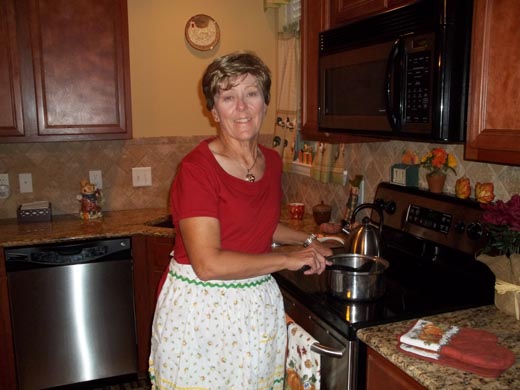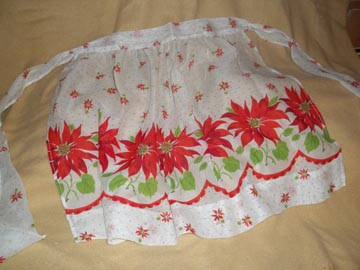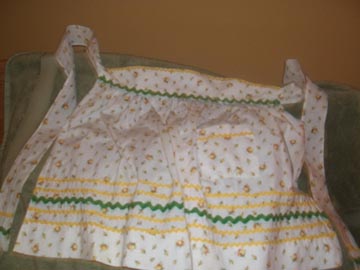Sara Etgen-Baker

© Copyright 2023 by Sara Etgen-Baker

Photo of Sara with apron made in 1965.
| Ties To The Past Sara Etgen-Baker  © Copyright 2023 by Sara Etgen-Baker |
 Photo of Sara with apron made in 1965. |
Mother always wore an apron; and anytime we cooked together in her kitchen, she insisted, “Put on your apron!” Since aprons were a part of being a homemaker and were synonymous with femininity and domesticity, I happily obliged her; retrieved one of her aprons; and tied it around my waist. And there was a time—and not so long ago—when every woman wore an apron. As a matter of fact, my mother and both of my grandmothers put on their aprons the moment they entered their kitchens and wore them throughout the day while preparing meals and tending to their household chores.
All three ladies were also seamstresses. So, they made their own aprons expressing their personalities and individuality with them. As I recall, Grandma Stainbrook made colorful, loose-fitting bib-style aprons with deep pockets. Grammy, on the other hand, preferred making dainty, pastel-colored half aprons that complemented her outfits and accentuated her tiny waist. My mother—a stout and practical woman—made bib-style aprons that she created from fabric remnants. She generally wore her bib-style apron to protect the dress underneath while saving her fancy half aprons accented with ribbon, lace, and appliques for holidays and entertaining.
 Mother's holiday apron |
 Sara's apron made in 1965 |  Grammy's tulip apron
|
Mother used her bib apron for almost everything—dusting furniture; drying my tears; picking up hot pans; wiping the sweat from her brow; and carrying my ailing kitten from the backyard into the house. Her bottomless apron pockets were always full and housed such items as clothespins, handkerchiefs, band aids, loose change, my jacks, and my brother’s marbles.
And at 14, I embraced the apron and sewing traditions enrolling in home economics class where I sewed my first garment—a half apron of my own. I bought the apron pattern for 65 cents but didn’t have enough money to purchase fabric. So, I used the remnants of mother’s kitchen curtain material—a white fabric covered in delicate yellow roses. During that first semester’s apron project, I learned sewing basic how to’s such as cutting out a pattern; pinning it to the fabric; cutting the fabric; and basting the garment. At some point, I learned to thread the sewing machine, maneuver the foot pedal, and guide the material under the advancing presser foot. And by semester’s end, I’d successfully sewn my apron to the waistband; attached small, rick-rack covered pockets to it; and hemmed it.
And there was something satisfying about taking a piece of fabric and turning it into a beautiful apron. I felt special, too; for sewing my own apron was a sort of rite of passage into womanhood. I, therefore, proudly wore my apron every chance I had. In 1965 I understood that aprons were a part of being both a woman and a homemaker; however, when the women’s movement took hold, aprons seemingly disappeared from favor and the feminine landscape.
But aprons remain important, for they are historical garments reflecting how women functioned in society; how culture viewed them; and how they saw themselves. I recall the women in my life who wore aprons and realize that the stories behind their aprons gave life and meaning to the fabric itself. Their aprons are statements of what they represented to their families and serve as reminders of recipes, values, events, and traditions from gentler, less complicated times. I remain fascinated with aprons, for each one has a unique story to tell with its own ties to the past.